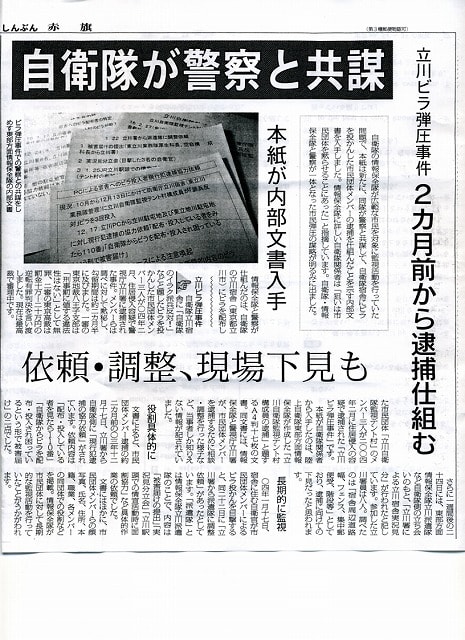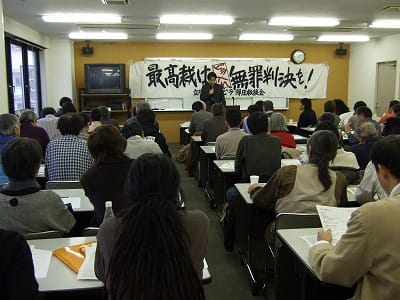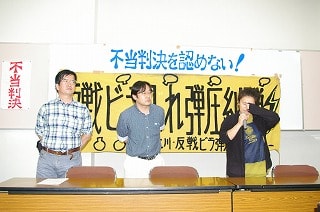自衛隊官舎にビラまきをした反戦運動家3人に対し、75日間も逮捕・勾留したうえ、最高裁が罰金10万円~20万円という高裁判決を認めたことは、日本における市民の自由がおかれた状況を示す格好の例だ。そこで、この判決を英訳し、日本の裁判所の判断の当否を世界の市民に考えてもらおうと思う。まずは、判決全文を掲載する。同時に下記URLにて、裁判所が自らなした英訳全文を掲載する。あなたの知り合いの外国人に英訳判決を見せて反応を教えてほしい。(ところで、英訳は原文に忠実になされているでしょうか?どなたか、ご確認いただければ助かります)
英訳のURL
vol.1 http://blog.goo.ne.jp/tokyodo-2005/e/b15bf213e32f2b439c876cb510cc5906
vol.2 http://blog.goo.ne.jp/tokyodo-2005/e/8df853cd075778ccf778202c4d6db558
voi.3 http://blog.goo.ne.jp/tokyodo-2005/e/23ef4eefe83e07d1efd4092ad735b663
vol.4 http://blog.goo.ne.jp/tokyodo-2005/e/6d525bf8c7c478e7ff3f5f10b4e79f54
■■以下、最高裁平成20年4月11日判決■■
主文
本件各上告を棄却する。
理由
第1 被告人3名の弁護人栗山れい子ほかの上告趣意のうち,本件被告人らの行
為をもって刑法130条前段の罪に問うことは憲法21条1項に違反するとの主張
について
1 原判決の認定及び記録によれば,本件の事実関係は,次のとおりである。
(1) 立川宿舎の状況等
ア 全般
東京都立川市所在の防衛庁(当時。以下同じ。)立川宿舎(以下「立川宿舎」と
いう。)の敷地は,南北に細長い長方形(南北方向の辺の長さは約400m,東西
方向の辺の長さは約50mである。以下「南側敷地」という。)の北端に東西に細
長い長方形(南北方向の辺の長さは約25m,東西方向の辺の長さは約130mで
ある。以下「北側敷地」という。)が西側に伸びる形で付いた逆L字形をしてい
る。南側敷地の東側,北側敷地の東側と北側が,一般道路に面し,南側敷地の西
側,北側敷地の西側と南側の西半分が,自衛隊東立川駐屯地と接している。南側敷
地の南半分には,南から北へ順に1号棟ないし8号棟の集合住宅が建っている。い
ずれも東西に細長い直方体であり,鉄筋4階建てで,各階に6室ずつある(1号棟
ないし8号棟の敷地の南北方向の辺の長さは約200mである。)。南側敷地の北
半分は,南北に細長い長方形の空き地(以下「北側空き地」という。)になってい
る。北側敷地には,東西に並んで東から西へ順に9号棟,10号棟の前同様の集合
住宅が建っている。ただし,9号棟及び10号棟は,いずれも5階建てで,10号
棟は各階に8室ずつある。
イ 立川宿舎の敷地の囲にょう状況
(ア) 1号棟ないし8号棟の敷地は,南側は高さ約1.5mの鉄製フェンス,一
般道路に面する東側は,高さ約1.5mないし約1.6mの鉄製フェンスないし金
網フェンス,北側空き地と接する北側は木製杭,自衛隊東立川駐屯地と接する西側
は,門扉のある通用門1か所のほかは,高さ約1.85mないし約2.1mの鉄製
フェンスで囲まれている。東側のフェンスは,各号棟の北側通路に通じる出入口と
なる部分がそれぞれ1号棟に係るものから順に幅約7.1m,約5.9m,約8
m,約6.1m,約6.3m,約5m,約9m,約6.1mにわたって開口してお
り,各開口部に門扉はない。北側の木製杭には,おおむね等間隔に4本の鉄線が張
られている。
(イ) 9号棟及び10号棟の敷地も,高さ約1.5mないし約1.7mの金網フ
ェンスないし鉄製フェンスで囲まれ,一般道路に面する東側,北側のフェンスは,
各号棟の出入口となる部分が幅数mないし約8.2mにわたって開口するなどして
おり,各開口部に門扉はない。
ウ 立川宿舎の敷地の案内板等の状況
(ア) 1号棟ないし8号棟の敷地の東側フェンスの1号棟の北側通路に通じる出
入口となる開口部付近に,「防衛庁立川宿舎案内図」と題する案内板がある。同フ
ェンスの各号棟の北側通路に通じる出入口となる各開口部の向かってすぐ左のフェ
ンス部分に,いずれも,A3判大の横長の白色の用紙に,縦書きで,
「宿舎地域内の禁止事項
一関係者以外,地域内に立ち入ること
一ビラ貼り・配り等の宣伝活動
一露店(土地の占有)等による物品販売及び押し売り
一車両の駐車
一その他,人に迷惑をかける行為
管理者」
と印刷されてビニールカバーが掛けられた禁止事項表示板が設置されている。
(イ) 9号棟及び10号棟の敷地を囲むフェンスの9号棟の出入口となる前記イ
(イ)の開口部付近に,前同様の「防衛庁立川宿舎案内図」と題する案内板があり,
同フェンスの各号棟の出入口となる前記イ(イ)の各開口部の向かってすぐ左ないし
右のフェンス部分に,前同様の禁止事項表示板が設置されている。
エ 各号棟の状況
(ア) 1号棟ないし9号棟には,それぞれ東側階段,中央階段,西側階段があ
り,各号棟の1階には,その北側に各階段ごとに各階段に通じる門扉のない3か所
の出入口があり,10号棟の1階には,その北側に,東側階段,東側中階段,西側
中階段,西側階段に通じる門扉のない4か所の出入口がある。これらの出入口に
は,それぞれ集合郵便受けが設置されている。これらの階段に面して各階2室ずつ
の玄関があり,各室玄関ドアには新聞受けが設置されている。
(イ) 1号棟ないし10号棟の1階出入口にある掲示板又は集合郵便受けの上部
の壁等には,A4判大の横長の白色又は黄色の用紙に,縦書きで,前記禁止事項表
示板と同じ文言が印刷された禁止事項表示物が,一部はビニールカバーが掛けられ
て,掲示されていた。
オ 立川宿舎の管理状況
立川宿舎は,防衛庁の職員及びその家族が居住するための国が設置する宿舎であ
る。本件当時,1号棟ないし8号棟は,ほぼ全室に居住者が入居していた。国家公
務員宿舎法,同法施行令等により,敷地及び5号棟ないし8号棟は陸上自衛隊東立
川駐屯地業務隊長の管理,1号棟ないし4号棟は航空自衛隊第1補給処立川支処長
の管理となっており,9号棟,10号棟は防衛庁契約本部ないし同庁技術研究本部
第3研究所の管理下にある。
(2) テント村の活動状況等
「立川自衛隊監視テント村」(以下「テント村」という。)は,自衛隊の米軍立
川基地移駐に際して結成された団体で,反戦平和を課題とし,示威運動,駅頭情報
宣伝活動,駐屯地に対する申入れ活動等を行っている。被告人3名は,いずれもテ
ント村の構成員として活動している者である。
(3) テント村の活動とこれに対する立川宿舎の管理者の対応
ア テント村は,平成15年夏に関連法律が成立して自衛隊のイラク派遣が迫っ
てきたころから,これに反対する活動として,駅頭情報宣伝活動やデモを積極的に
行うようになった。
イ テント村は,自衛官及びその家族に向けて,平成15年10月中ごろ,同年
11月終わりころ,同年12月13日と月1回の割合で,それぞれ,「自衛官のみ
なさん・家族のみなさんへイラクへの派兵が,何をもたらすというのか?」,
「自衛官のみなさん・家族のみなさんへ殺すのも・殺されるのもイヤだと言お
う」,「イラクへ行くな,自衛隊! 戦争では何も解決しない」との表題の下に,
自衛隊のイラク派遣に反対し,かつ,自衛官に対しイラク派兵に反対するよう促
し,自衛官のためのホットラインの存在を知らせる内容のA4判大のビラを,立川
宿舎の各号棟の1階出入口の集合郵便受け又は各室玄関ドアの新聞受けに投かんし
た。
ウ 前記イの平成15年12月13日のビラの投かん後,陸上自衛隊東立川駐屯
地業務隊長の職務を補佐する同業務隊厚生科長,航空自衛隊第1補給処立川支処長
の職務を補佐する同支処業務課長ら立川宿舎の管理業務に携わっていた者は,連絡
を取り合った上,管理者の意を受けて,それぞれの管理部分ごとに分担するなどし
て,同月18日,前記(1)ウ(ア),(イ)のとおり,禁止事項表示板を立川宿舎の敷
地の一般道路に面するフェンスの各号棟の出入口となる各開口部のすぐわきのフェ
ンス部分に設置し,同月19日から同月24日にかけて,前記(1)エ(イ)のとお
り,禁止事項表示物を各号棟の1階出入口に掲示した。
エ そのころ,前記イの平成15年12月13日のビラの投かんについて,立川
宿舎の管理業務に携わっていた者により管理者の意を受けて警察に住居侵入の被害
届が提出された。
(4) 本件ビラ投かんの状況等
ア 被告人3名は,共謀の上,テント村の活動の一環として,「自衛官・ご家族
の皆さんへ自衛隊のイラク派兵反対! いっしょに考え,反対の声をあげよ
う!」との表題の下,前同様の内容のA4判大のビラを,立川宿舎の各号棟の各室
玄関ドアの新聞受けに投かんする目的で,平成16年1月17日午前11時30分
過ぎころから午後0時ころまでの間,立川宿舎の敷地内に3名とも立ち入った上,
分担して,3号棟東側階段,同棟中央階段,5号棟東側階段,6号棟東側階段及び
7号棟西側階段に通じる各1階出入口からそれぞれ4階の各室玄関前まで立ち入
り,各室玄関ドアの新聞受けに上記ビラを投かんするなどした。
イ 平成16年1月23日,前記アのビラの投かんについて,立川宿舎の管理業
務に携わっていた者により管理者の意を受けて警察に住居侵入の被害届が提出され
た。なお,同年2月3日に実施された実況見分時には,1号棟及び9号棟の各出入
口並びに3号棟の中央出入口,4号棟の東側出入口,5号棟の西側出入口及び8号
棟の西側出入口には,前記(1)エ(イ)の禁止事項表示物がなかった。
ウ 被告人A及び同Bは,共謀の上,テント村の活動の一環として,「ブッシュ
も小泉も戦場には行かない」との表題の下,前同様の内容のA4判大のビラを,立
川宿舎の各号棟の各室玄関ドアの新聞受けに投かんする目的で,平成16年2月2
2日午前11時30分過ぎころから午後0時過ぎころまでの間,立川宿舎の敷地内
に2名とも立ち入った上,分担して,3号棟西側階段,5号棟西側階段及び7号棟
西側階段に通じる各1階出入口からそれぞれ4階の各室玄関前まで立ち入り,各室
玄関ドアの新聞受けに上記ビラを投かんするなどした。
エ 平成16年3月22日,前記ウのビラの投かんについて,立川宿舎の管理業
務に携わっていた者により管理者の意を受けて警察に住居侵入の被害届が提出され
た。
2(1) 前記1(4)ア,ウのとおり,被告人らは,立川宿舎の敷地内に入り込み,
各号棟の1階出入口から各室玄関前まで立ち入ったものであり,当該立入りについ
て刑法130条前段の罪に問われているので,まず,被告人らが立ち入った場所が
同条にいう「人の住居」,「人の看守する邸宅」,「人の看守する建造物」のいず
れかに当たるのかを検討する。
(2) 前記1の立川宿舎の各号棟の構造及び出入口の状況,その敷地と周辺土地
や道路との囲障等の状況,その管理の状況等によれば,各号棟の1階出入口から各
室玄関前までの部分は,居住用の建物である宿舎の各号棟の建物の一部であり,宿
舎管理者の管理に係るものであるから,居住用の建物の一部として刑法130条に
いう「人の看守する邸宅」に当たるものと解され,また,各号棟の敷地のうち建築
物が建築されている部分を除く部分は,各号棟の建物に接してその周辺に存在し,
かつ,管理者が外部との境界に門塀等の囲障を設置することにより,これが各号棟
の建物の付属地として建物利用のために供されるものであることを明示していると
認められるから,上記部分は,「人の看守する邸宅」の囲にょう地として,邸宅侵
入罪の客体になるものというべきである(最高裁昭和49年(あ)第736号同5
1年3月4日第一小法廷判決・刑集30巻2号79頁参照)。
(3) そして,刑法130条前段にいう「侵入し」とは,他人の看守する邸宅等
に管理権者の意思に反して立ち入ることをいうものであるところ(最高裁昭和55
年(あ)第906号同58年4月8日第二小法廷判決・刑集37巻3号215頁参
照),立川宿舎の管理権者は,前記1(1)オのとおりであり,被告人らの立入りが
これらの管理権者の意思に反するものであったことは,前記1の事実関係から明ら
かである。
(4) そうすると,被告人らの本件立川宿舎の敷地及び各号棟の1階出入口から
各室玄関前までへの立入りは,刑法130条前段に該当するものと解すべきであ
る。なお,本件被告人らの立入りの態様,程度は前記1の事実関係のとおりであっ
て,管理者からその都度被害届が提出されていることなどに照らすと,所論のよう
に法益侵害の程度が極めて軽微なものであったなどということもできない。
3(1) 所論は,本件被告人らの行為をもって刑法130条前段の罪に問うこと
は憲法21条1項に違反するという。
(2) 確かに,表現の自由は,民主主義社会において特に重要な権利として尊重
されなければならず,被告人らによるその政治的意見を記載したビラの配布は,表
現の自由の行使ということができる。しかしながら,憲法21条1項も,表現の自
由を絶対無制限に保障したものではなく,公共の福祉のため必要かつ合理的な制限
を是認するものであって,たとえ思想を外部に発表するための手段であっても,そ
の手段が他人の権利を不当に害するようなものは許されないというべきである(最
高裁昭和59年(あ)第206号同年12月18日第三小法廷判決・刑集38巻1
2号3026頁参照)。本件では,表現そのものを処罰することの憲法適合性が問
われているのではなく,表現の手段すなわちビラの配布のために「人の看守する邸
宅」に管理権者の承諾なく立ち入ったことを処罰することの憲法適合性が問われて
いるところ,本件で被告人らが立ち入った場所は,防衛庁の職員及びその家族が私
的生活を営む場所である集合住宅の共用部分及びその敷地であり,自衛隊・防衛庁
当局がそのような場所として管理していたもので,一般に人が自由に出入りするこ
とのできる場所ではない。たとえ表現の自由の行使のためとはいっても,このよう
な場所に管理権者の意思に反して立ち入ることは,管理権者の管理権を侵害するの
みならず,そこで私的生活を営む者の私生活の平穏を侵害するものといわざるを得
ない。したがって,本件被告人らの行為をもって刑法130条前段の罪に問うこと
は,憲法21条1項に違反するものではない。このように解することができること
は,当裁判所の判例(昭和41年(あ)第536号同43年12月18日大法廷判
決・刑集22巻13号1549頁,昭和42年(あ)第1626号同45年6月1
7日大法廷判決・刑集24巻6号280頁)の趣旨に徴して明らかである。所論は
理由がない。
第2 その余の主張について
憲法違反,判例違反をいう点を含め,実質は単なる法令違反,事実誤認の主張で
あって,刑訴法405条の上告理由に当たらない。
よって,同法408条により,裁判官全員一致の意見で,主文のとおり判決す
る。
(裁判長裁判官今井功裁判官津野修裁判官中川了滋)
【PR】
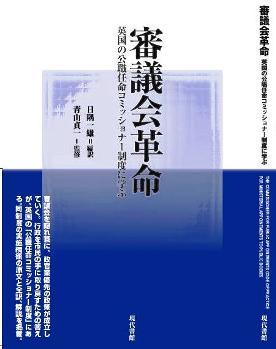
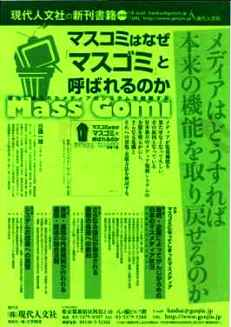
★「憎しみはダークサイドへの道、苦しみと痛みへの道なのじゃ」(マスター・ヨーダ)
★「政策を決めるのはその国の指導者です。そして,国民は,つねにその指導者のいいなりになるように仕向けられます。方法は簡単です。一般的な国民に向かっては,われわれは攻撃されかかっているのだと伝え,戦意を煽ります。平和主義者に対しては,愛国心が欠けていると非難すればいいのです。このやりかたはどんな国でも有効です」(ヒトラーの側近ヘルマン・ゲーリング。ナチスドイツを裁いたニュルンベルグ裁判にて)
★「News for the People in Japanを広めることこそ日本の民主化実現への有効な手段だ(笑)」(ヤメ蚊)
※このブログのトップページへはここ←をクリックして下さい。過去記事はENTRY ARCHIVE・過去の記事,分野別で読むにはCATEGORY・カテゴリからそれぞれ選択して下さい。
また,このブログの趣旨の紹介及びTB&コメントの際のお願いはこちら(←クリック)まで。なお、多忙につき、試行的に、コメントの反映はしないようにします。コメント内容の名誉毀損性、プライバシー侵害性についての確認をすることが難しいためです。情報提供、提案、誤りの指摘などは、コメント欄を通じて、今後ともよろしくお願いします。転載、引用はこれまでどおり大歓迎です。
英訳のURL
vol.1 http://blog.goo.ne.jp/tokyodo-2005/e/b15bf213e32f2b439c876cb510cc5906
vol.2 http://blog.goo.ne.jp/tokyodo-2005/e/8df853cd075778ccf778202c4d6db558
voi.3 http://blog.goo.ne.jp/tokyodo-2005/e/23ef4eefe83e07d1efd4092ad735b663
vol.4 http://blog.goo.ne.jp/tokyodo-2005/e/6d525bf8c7c478e7ff3f5f10b4e79f54
■■以下、最高裁平成20年4月11日判決■■
主文
本件各上告を棄却する。
理由
第1 被告人3名の弁護人栗山れい子ほかの上告趣意のうち,本件被告人らの行
為をもって刑法130条前段の罪に問うことは憲法21条1項に違反するとの主張
について
1 原判決の認定及び記録によれば,本件の事実関係は,次のとおりである。
(1) 立川宿舎の状況等
ア 全般
東京都立川市所在の防衛庁(当時。以下同じ。)立川宿舎(以下「立川宿舎」と
いう。)の敷地は,南北に細長い長方形(南北方向の辺の長さは約400m,東西
方向の辺の長さは約50mである。以下「南側敷地」という。)の北端に東西に細
長い長方形(南北方向の辺の長さは約25m,東西方向の辺の長さは約130mで
ある。以下「北側敷地」という。)が西側に伸びる形で付いた逆L字形をしてい
る。南側敷地の東側,北側敷地の東側と北側が,一般道路に面し,南側敷地の西
側,北側敷地の西側と南側の西半分が,自衛隊東立川駐屯地と接している。南側敷
地の南半分には,南から北へ順に1号棟ないし8号棟の集合住宅が建っている。い
ずれも東西に細長い直方体であり,鉄筋4階建てで,各階に6室ずつある(1号棟
ないし8号棟の敷地の南北方向の辺の長さは約200mである。)。南側敷地の北
半分は,南北に細長い長方形の空き地(以下「北側空き地」という。)になってい
る。北側敷地には,東西に並んで東から西へ順に9号棟,10号棟の前同様の集合
住宅が建っている。ただし,9号棟及び10号棟は,いずれも5階建てで,10号
棟は各階に8室ずつある。
イ 立川宿舎の敷地の囲にょう状況
(ア) 1号棟ないし8号棟の敷地は,南側は高さ約1.5mの鉄製フェンス,一
般道路に面する東側は,高さ約1.5mないし約1.6mの鉄製フェンスないし金
網フェンス,北側空き地と接する北側は木製杭,自衛隊東立川駐屯地と接する西側
は,門扉のある通用門1か所のほかは,高さ約1.85mないし約2.1mの鉄製
フェンスで囲まれている。東側のフェンスは,各号棟の北側通路に通じる出入口と
なる部分がそれぞれ1号棟に係るものから順に幅約7.1m,約5.9m,約8
m,約6.1m,約6.3m,約5m,約9m,約6.1mにわたって開口してお
り,各開口部に門扉はない。北側の木製杭には,おおむね等間隔に4本の鉄線が張
られている。
(イ) 9号棟及び10号棟の敷地も,高さ約1.5mないし約1.7mの金網フ
ェンスないし鉄製フェンスで囲まれ,一般道路に面する東側,北側のフェンスは,
各号棟の出入口となる部分が幅数mないし約8.2mにわたって開口するなどして
おり,各開口部に門扉はない。
ウ 立川宿舎の敷地の案内板等の状況
(ア) 1号棟ないし8号棟の敷地の東側フェンスの1号棟の北側通路に通じる出
入口となる開口部付近に,「防衛庁立川宿舎案内図」と題する案内板がある。同フ
ェンスの各号棟の北側通路に通じる出入口となる各開口部の向かってすぐ左のフェ
ンス部分に,いずれも,A3判大の横長の白色の用紙に,縦書きで,
「宿舎地域内の禁止事項
一関係者以外,地域内に立ち入ること
一ビラ貼り・配り等の宣伝活動
一露店(土地の占有)等による物品販売及び押し売り
一車両の駐車
一その他,人に迷惑をかける行為
管理者」
と印刷されてビニールカバーが掛けられた禁止事項表示板が設置されている。
(イ) 9号棟及び10号棟の敷地を囲むフェンスの9号棟の出入口となる前記イ
(イ)の開口部付近に,前同様の「防衛庁立川宿舎案内図」と題する案内板があり,
同フェンスの各号棟の出入口となる前記イ(イ)の各開口部の向かってすぐ左ないし
右のフェンス部分に,前同様の禁止事項表示板が設置されている。
エ 各号棟の状況
(ア) 1号棟ないし9号棟には,それぞれ東側階段,中央階段,西側階段があ
り,各号棟の1階には,その北側に各階段ごとに各階段に通じる門扉のない3か所
の出入口があり,10号棟の1階には,その北側に,東側階段,東側中階段,西側
中階段,西側階段に通じる門扉のない4か所の出入口がある。これらの出入口に
は,それぞれ集合郵便受けが設置されている。これらの階段に面して各階2室ずつ
の玄関があり,各室玄関ドアには新聞受けが設置されている。
(イ) 1号棟ないし10号棟の1階出入口にある掲示板又は集合郵便受けの上部
の壁等には,A4判大の横長の白色又は黄色の用紙に,縦書きで,前記禁止事項表
示板と同じ文言が印刷された禁止事項表示物が,一部はビニールカバーが掛けられ
て,掲示されていた。
オ 立川宿舎の管理状況
立川宿舎は,防衛庁の職員及びその家族が居住するための国が設置する宿舎であ
る。本件当時,1号棟ないし8号棟は,ほぼ全室に居住者が入居していた。国家公
務員宿舎法,同法施行令等により,敷地及び5号棟ないし8号棟は陸上自衛隊東立
川駐屯地業務隊長の管理,1号棟ないし4号棟は航空自衛隊第1補給処立川支処長
の管理となっており,9号棟,10号棟は防衛庁契約本部ないし同庁技術研究本部
第3研究所の管理下にある。
(2) テント村の活動状況等
「立川自衛隊監視テント村」(以下「テント村」という。)は,自衛隊の米軍立
川基地移駐に際して結成された団体で,反戦平和を課題とし,示威運動,駅頭情報
宣伝活動,駐屯地に対する申入れ活動等を行っている。被告人3名は,いずれもテ
ント村の構成員として活動している者である。
(3) テント村の活動とこれに対する立川宿舎の管理者の対応
ア テント村は,平成15年夏に関連法律が成立して自衛隊のイラク派遣が迫っ
てきたころから,これに反対する活動として,駅頭情報宣伝活動やデモを積極的に
行うようになった。
イ テント村は,自衛官及びその家族に向けて,平成15年10月中ごろ,同年
11月終わりころ,同年12月13日と月1回の割合で,それぞれ,「自衛官のみ
なさん・家族のみなさんへイラクへの派兵が,何をもたらすというのか?」,
「自衛官のみなさん・家族のみなさんへ殺すのも・殺されるのもイヤだと言お
う」,「イラクへ行くな,自衛隊! 戦争では何も解決しない」との表題の下に,
自衛隊のイラク派遣に反対し,かつ,自衛官に対しイラク派兵に反対するよう促
し,自衛官のためのホットラインの存在を知らせる内容のA4判大のビラを,立川
宿舎の各号棟の1階出入口の集合郵便受け又は各室玄関ドアの新聞受けに投かんし
た。
ウ 前記イの平成15年12月13日のビラの投かん後,陸上自衛隊東立川駐屯
地業務隊長の職務を補佐する同業務隊厚生科長,航空自衛隊第1補給処立川支処長
の職務を補佐する同支処業務課長ら立川宿舎の管理業務に携わっていた者は,連絡
を取り合った上,管理者の意を受けて,それぞれの管理部分ごとに分担するなどし
て,同月18日,前記(1)ウ(ア),(イ)のとおり,禁止事項表示板を立川宿舎の敷
地の一般道路に面するフェンスの各号棟の出入口となる各開口部のすぐわきのフェ
ンス部分に設置し,同月19日から同月24日にかけて,前記(1)エ(イ)のとお
り,禁止事項表示物を各号棟の1階出入口に掲示した。
エ そのころ,前記イの平成15年12月13日のビラの投かんについて,立川
宿舎の管理業務に携わっていた者により管理者の意を受けて警察に住居侵入の被害
届が提出された。
(4) 本件ビラ投かんの状況等
ア 被告人3名は,共謀の上,テント村の活動の一環として,「自衛官・ご家族
の皆さんへ自衛隊のイラク派兵反対! いっしょに考え,反対の声をあげよ
う!」との表題の下,前同様の内容のA4判大のビラを,立川宿舎の各号棟の各室
玄関ドアの新聞受けに投かんする目的で,平成16年1月17日午前11時30分
過ぎころから午後0時ころまでの間,立川宿舎の敷地内に3名とも立ち入った上,
分担して,3号棟東側階段,同棟中央階段,5号棟東側階段,6号棟東側階段及び
7号棟西側階段に通じる各1階出入口からそれぞれ4階の各室玄関前まで立ち入
り,各室玄関ドアの新聞受けに上記ビラを投かんするなどした。
イ 平成16年1月23日,前記アのビラの投かんについて,立川宿舎の管理業
務に携わっていた者により管理者の意を受けて警察に住居侵入の被害届が提出され
た。なお,同年2月3日に実施された実況見分時には,1号棟及び9号棟の各出入
口並びに3号棟の中央出入口,4号棟の東側出入口,5号棟の西側出入口及び8号
棟の西側出入口には,前記(1)エ(イ)の禁止事項表示物がなかった。
ウ 被告人A及び同Bは,共謀の上,テント村の活動の一環として,「ブッシュ
も小泉も戦場には行かない」との表題の下,前同様の内容のA4判大のビラを,立
川宿舎の各号棟の各室玄関ドアの新聞受けに投かんする目的で,平成16年2月2
2日午前11時30分過ぎころから午後0時過ぎころまでの間,立川宿舎の敷地内
に2名とも立ち入った上,分担して,3号棟西側階段,5号棟西側階段及び7号棟
西側階段に通じる各1階出入口からそれぞれ4階の各室玄関前まで立ち入り,各室
玄関ドアの新聞受けに上記ビラを投かんするなどした。
エ 平成16年3月22日,前記ウのビラの投かんについて,立川宿舎の管理業
務に携わっていた者により管理者の意を受けて警察に住居侵入の被害届が提出され
た。
2(1) 前記1(4)ア,ウのとおり,被告人らは,立川宿舎の敷地内に入り込み,
各号棟の1階出入口から各室玄関前まで立ち入ったものであり,当該立入りについ
て刑法130条前段の罪に問われているので,まず,被告人らが立ち入った場所が
同条にいう「人の住居」,「人の看守する邸宅」,「人の看守する建造物」のいず
れかに当たるのかを検討する。
(2) 前記1の立川宿舎の各号棟の構造及び出入口の状況,その敷地と周辺土地
や道路との囲障等の状況,その管理の状況等によれば,各号棟の1階出入口から各
室玄関前までの部分は,居住用の建物である宿舎の各号棟の建物の一部であり,宿
舎管理者の管理に係るものであるから,居住用の建物の一部として刑法130条に
いう「人の看守する邸宅」に当たるものと解され,また,各号棟の敷地のうち建築
物が建築されている部分を除く部分は,各号棟の建物に接してその周辺に存在し,
かつ,管理者が外部との境界に門塀等の囲障を設置することにより,これが各号棟
の建物の付属地として建物利用のために供されるものであることを明示していると
認められるから,上記部分は,「人の看守する邸宅」の囲にょう地として,邸宅侵
入罪の客体になるものというべきである(最高裁昭和49年(あ)第736号同5
1年3月4日第一小法廷判決・刑集30巻2号79頁参照)。
(3) そして,刑法130条前段にいう「侵入し」とは,他人の看守する邸宅等
に管理権者の意思に反して立ち入ることをいうものであるところ(最高裁昭和55
年(あ)第906号同58年4月8日第二小法廷判決・刑集37巻3号215頁参
照),立川宿舎の管理権者は,前記1(1)オのとおりであり,被告人らの立入りが
これらの管理権者の意思に反するものであったことは,前記1の事実関係から明ら
かである。
(4) そうすると,被告人らの本件立川宿舎の敷地及び各号棟の1階出入口から
各室玄関前までへの立入りは,刑法130条前段に該当するものと解すべきであ
る。なお,本件被告人らの立入りの態様,程度は前記1の事実関係のとおりであっ
て,管理者からその都度被害届が提出されていることなどに照らすと,所論のよう
に法益侵害の程度が極めて軽微なものであったなどということもできない。
3(1) 所論は,本件被告人らの行為をもって刑法130条前段の罪に問うこと
は憲法21条1項に違反するという。
(2) 確かに,表現の自由は,民主主義社会において特に重要な権利として尊重
されなければならず,被告人らによるその政治的意見を記載したビラの配布は,表
現の自由の行使ということができる。しかしながら,憲法21条1項も,表現の自
由を絶対無制限に保障したものではなく,公共の福祉のため必要かつ合理的な制限
を是認するものであって,たとえ思想を外部に発表するための手段であっても,そ
の手段が他人の権利を不当に害するようなものは許されないというべきである(最
高裁昭和59年(あ)第206号同年12月18日第三小法廷判決・刑集38巻1
2号3026頁参照)。本件では,表現そのものを処罰することの憲法適合性が問
われているのではなく,表現の手段すなわちビラの配布のために「人の看守する邸
宅」に管理権者の承諾なく立ち入ったことを処罰することの憲法適合性が問われて
いるところ,本件で被告人らが立ち入った場所は,防衛庁の職員及びその家族が私
的生活を営む場所である集合住宅の共用部分及びその敷地であり,自衛隊・防衛庁
当局がそのような場所として管理していたもので,一般に人が自由に出入りするこ
とのできる場所ではない。たとえ表現の自由の行使のためとはいっても,このよう
な場所に管理権者の意思に反して立ち入ることは,管理権者の管理権を侵害するの
みならず,そこで私的生活を営む者の私生活の平穏を侵害するものといわざるを得
ない。したがって,本件被告人らの行為をもって刑法130条前段の罪に問うこと
は,憲法21条1項に違反するものではない。このように解することができること
は,当裁判所の判例(昭和41年(あ)第536号同43年12月18日大法廷判
決・刑集22巻13号1549頁,昭和42年(あ)第1626号同45年6月1
7日大法廷判決・刑集24巻6号280頁)の趣旨に徴して明らかである。所論は
理由がない。
第2 その余の主張について
憲法違反,判例違反をいう点を含め,実質は単なる法令違反,事実誤認の主張で
あって,刑訴法405条の上告理由に当たらない。
よって,同法408条により,裁判官全員一致の意見で,主文のとおり判決す
る。
(裁判長裁判官今井功裁判官津野修裁判官中川了滋)
【PR】


★「憎しみはダークサイドへの道、苦しみと痛みへの道なのじゃ」(マスター・ヨーダ)
★「政策を決めるのはその国の指導者です。そして,国民は,つねにその指導者のいいなりになるように仕向けられます。方法は簡単です。一般的な国民に向かっては,われわれは攻撃されかかっているのだと伝え,戦意を煽ります。平和主義者に対しては,愛国心が欠けていると非難すればいいのです。このやりかたはどんな国でも有効です」(ヒトラーの側近ヘルマン・ゲーリング。ナチスドイツを裁いたニュルンベルグ裁判にて)
★「News for the People in Japanを広めることこそ日本の民主化実現への有効な手段だ(笑)」(ヤメ蚊)
※このブログのトップページへはここ←をクリックして下さい。過去記事はENTRY ARCHIVE・過去の記事,分野別で読むにはCATEGORY・カテゴリからそれぞれ選択して下さい。
また,このブログの趣旨の紹介及びTB&コメントの際のお願いはこちら(←クリック)まで。なお、多忙につき、試行的に、コメントの反映はしないようにします。コメント内容の名誉毀損性、プライバシー侵害性についての確認をすることが難しいためです。情報提供、提案、誤りの指摘などは、コメント欄を通じて、今後ともよろしくお願いします。転載、引用はこれまでどおり大歓迎です。










